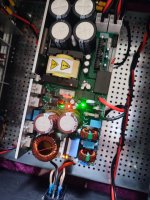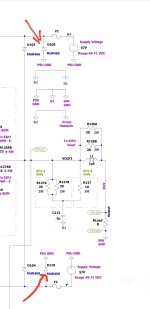Did you test the IMD for 19 and 20kHz ??Thank you it has been a work in progress for sure! I have measured the IMD on multiple builds and it measures just as good as the rest. What specific IMD test and level would you like to see? The English from the translator is perfect by the way.
I can get that for you, leave it with me.Did you test the IMD for 19 and 20kHz ??
Hello guys
I finished building my AMP yesterday and I was brave enough to start in today. Unfortunately I could not get any sounds out of it 🙁
I used the SMPS Cobra-S2 from Microaudio but it seems to go directly into protect mode, at least the LED is red. Does anyone of you have an idea what I'm doing wrong?


I finished building my AMP yesterday and I was brave enough to start in today. Unfortunately I could not get any sounds out of it 🙁
I used the SMPS Cobra-S2 from Microaudio but it seems to go directly into protect mode, at least the LED is red. Does anyone of you have an idea what I'm doing wrong?

I made a pretty stupid mistake.
I unfortunately connected the boards as if they were symmetrical and well, then I stupidly confused + and -.
I unfortunately connected the boards as if they were symmetrical and well, then I stupidly confused + and -.
Strangely enough, I got the channel that was connected incorrectly to run briefly. Then I unplugged the cables of the connector and plugged again because I thought maybe they are too loose on the other channel. I then checked both again but after that I had no sound on the briefly working channel.
I'll get to it tomorrow, today I'm done
I'll get to it tomorrow, today I'm done
Thank you for building in such features, Sam. 🙂
@poiy The amplifier has reverse polarity protection. It you connected your DC rail voltage incorrectly the Amplifiers rail fuses would have immediately blown.
Attachments
The SMPS protection circuit is too fast to allow the fuses to blow.
I suggest that you test your amplifiers using a low current power supply before powering them from the SMPS again.I made a pretty stupid mistake.
I unfortunately connected the boards as if they were symmetrical and well, then I stupidly confused + and -.
Thanks
Agree, I would use a dim bulb tester and/or a variac.
Gaetano.
Gaetano.
Yes, stacking them gives you the opportunity to cancel fields. I was surprised to see the data sheet where stacking was contra-indicated. It was only in one that I came across while looking at various transformer manufacturers. I cannot seem to find it again. My real point is to look at the manufacturer's data sheet carefully.I have heard the opposite.
I've heard that stacking them gives you the opportunity to rotate and flip them to reduce/cancel the noise and EMI
produced.
Twin Toroids
There are two possible reasons I can think of not to stack. One is the added torque on the longer mounting bolt. Second is the fact that stacking reduces the area through which heat can be dissipated. This latter is not likely to be a problem in use, but might show up during testing.
Check the build guide. Limit the current to what it mentions or 75% of your fuse rating should be ok for start up checking. Also 30v rails is sufficient voltage to do an initial test.what should I limit current to
- Home
- Amplifiers
- Solid State
- DIY Class A/B Amp The "Wolverine" build thread
